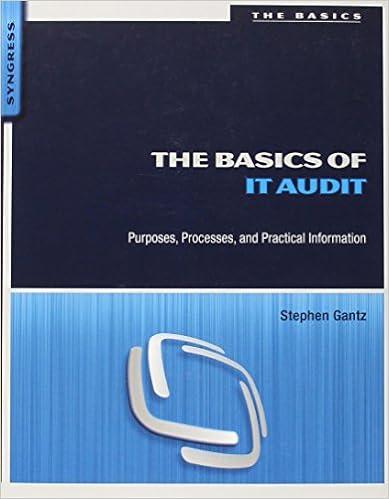Question
[1] According to SFAS 34, Capitalization of Interest Costs, interest should be capitalized for assets that are A. In use or ready for their intended
[1] According to SFAS 34, Capitalization of Interest Costs, interest should be capitalized for assets that are
A. In use or ready for their intended use in the earning activities of the enterprise.
B. Being constructed or otherwise being produced as discrete projects for an enterprise's own use.
C. Not being used in the earning activities of the enterprise and not undergoing the activities necessary
to get them ready for use.
D. Routinely produced.
[2] On July 1, 2002, one of Damon Co.'s delivery vans was destroyed in an accident. On that date, the van's carrying amount was $2,500. On July 15, 2002, Damon received and recorded a $700 invoice for a new engine installed in the van in May 2002, and another $500 invoice for various repairs. In August, Damon received $3,500 under its insurance policy on the van, which it plans to use to replace the van. What amount should Damon report as gain (loss) on disposal of the van in its 2002 income statement?
A. $1,000
B. $300
C. $0
D. $(200)
[3] In an exchange of similar assets, Junger Co. received equipment with a fair value equal to the carrying amount of equipment given up. Junger also contributed cash equal to 10% of the fair value of the exchange. As a result of the exchange, Junger recognized
A. A loss equal to the cash given up.
B. A loss determined by the proportion of cash paid to the total transaction value.
C. A gain determined by the proportion of cash paid to the total transaction value.
D. Neither gain nor loss.
[4] Bell and Mayo are independent companies. Each owns a tract of land being held for development; however, each would prefer to build on the other's land. Accordingly, the companies agree to exchange their land. An appraiser was hired, and from the appraisal report and the companies' records, the following information was obtained:
Bell's Land Mayo's Land
----------- -----------
Cost and carrying amount $ 80,000 $50,000
Fair value based upon appraisal 100,000 85,000
Given this information, the land parcels were exchanged and, based on the difference in appraised fair values, Mayo paid $15,000 to Bell. At what amount should Mayo record the land received on its books?
A. $100,000
B. $85,000
C. $65,000
D. $50,000
[5] Essen Co. and Potsdam Co. are fuel oil distributors. To facilitate the delivery of oil to their customers, Essen and Potsdam exchanged ownership of 1,200 barrels of oil without physically moving the oil. Essen paid Potsdam $30,000 to compensate for a difference in the grade of oil. On the date of the exchange, cost and fair values of the oil were as follows:
Essen Co. Potsdam Co.
--------- -----------
Cost $100,000 $126,000
Fair values 120,000 150,000
In Potsdam's income statement, what amount of gain should be reported from the exchange of the oil?
A. $0
B. $4,800
C. $24,000
D. $30,000
[6] On July 1, 2002, Trey Co. exchanged a truck for 25 shares of Deuce Corp.'s common stock. On that date, the truck's carrying amount was $2,500, and its fair value was $3,000. Also, the carrying amount of Deuce's stock was $60 per share. On December 31, 2002, Deuce had 250 shares of common stock outstanding and its carrying amount per share was $50. What amount should Trey report in its December 31, 2002 balance sheet as investment in Deuce?
A. $3,000
B. $2,500
C. $1,500
D. $1,250
[7] Khartoum Co. purchased equipment on January 2, 2000 for $50,000. The equipment had an estimated 5-year service life. Khartoum's policy for 5-year assets is to use the 200%-double-declining-balance depreciation method for the first 2 years of the asset's life and then switch to the straight-line depreciation method. In its December 31, 2002 balance sheet, what amount should Khartoum report as accumulated depreciation for equipment?
A. $30,000
B. $38,000
C. $39,200
D. $42,000
Information for Questions 8-10:
Samoa Corporation's schedule of depreciable assets at December 31, 2001 is shown below. Samoa takes a full year's depreciation expense in the year of an asset's acquisition, and no depreciation expense in the year of an asset's disposition. The estimated useful life of each depreciable asset is 5 years.
Accumulated Acquisition Salvage
Asset Cost Depreciation Date Value
----- -------- ------------ ----------- -------
A $100,000 $ 64,000 2000 $20,000
B 55,000 36,000 1999 10,000
C 70,000 33,600 1999 14,000
-------- -------- -------
$225,000 $133,600 $44,000
======== ======== =======
[8] Samoa depreciates asset A on the double-declining-balance method. How much depreciation expense should Samoa record in 2002 for asset A?
A. $32,000
B. $24,000
C. $14,400
D. $1,600
[9] Using the same depreciation method as used in 1999, 2000, and 2001, how much depreciation expense should Samoa record in 2002 for asset B?
A. $6,000
B. $9,000
C. $12,000
D. $15,000
[10] Samoa depreciates asset C by the straight-line method. On June 30, 2002, Samoa sold asset C for $28,000 cash. How much gain or (loss) should Samoa record in 2002 on the disposal of asset C?
A. $2,800
B. $(2,800)
C. $(5,600)
D. $(8,400)
Step by Step Solution
There are 3 Steps involved in it
Step: 1

Get Instant Access to Expert-Tailored Solutions
See step-by-step solutions with expert insights and AI powered tools for academic success
Step: 2

Step: 3

Ace Your Homework with AI
Get the answers you need in no time with our AI-driven, step-by-step assistance
Get Started


